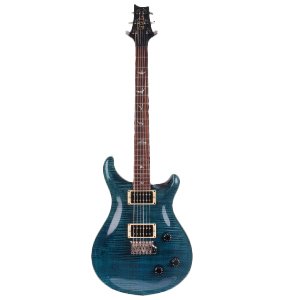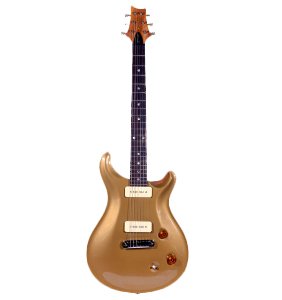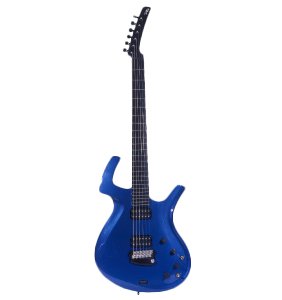Rock and jazz are radical forms of music, but the guitarists who play them often have surprisingly conservative views about instrument design. Over half a century since their introduction, the classic Fender and Gibson solid-bodies are as popular as ever, and some musicians still consider them to be without equal in terms of sound and feel. Significantly, a number of contemporary guitar makers share their customers' reverence for the past, and seek to develop and combine aspects of the old 'favourites' in their current models.
Maryland-based luthier Paul Reed Smith (b.1956) uses this approach brilliantly. His elegant, versatile guitars, while full of new ideas, frequently incorporate two familiar features: Gibson Les Paul-style carved tops and glued-in necks, and Fender Stratocaster-like double cutaways. Smith's designs evolved through years of experimentation and 'field-testing' in live performance. As a struggling young craftsman in Annapolis, he would obtain backstage passes to concert venues and offer his instruments to star players on the understanding that "if [they] didn't love the guitars they didn't have to pay me, even when I knew I couldn't make my rent the next day." His efforts paid off handsomely, and today PRS electrics (made in Stevensville, Maryland, some 20 miles from Smith's hometown, Bowie) are associated with distinguished artists such as Carlos Santana, Alex Lifeson of Rush, Al Di Meola, Ted Nugent, and Dweezil Zappa (son of Frank).
At first sight, there is absolutely nothing traditional or orthodox about the work of another leading American luthier, Ken Parker, whose Fly Deluxe can be seen here. But beneath the instrument's thin, rigid outer layer (made from carbon and fibre-glass) is a core of resonant wood, and Parker has likened its design to that of Renaissance lutes, whose sound was similarly enhanced by the use of softwoods covered in ebony veneers. The Fly's electronics offer players an exceptionally wide tonal palette, and unlike conventional electrics, it is remarkably light, weighing in at less than 5lb (2.3kg). Since their introduction in 1993, Parkers have been played by many major names, including Joe Walsh of The Eagles, King Crimson's Adrian Belew, and David Bowie's former guitarist Reeves Gabrels. Ken Parker sold his company in 2003 (it continues to make Flys and other innovative electrics), and he currently specialises in building high-end acoustic archtop guitars.

PRS CUSTOM 22, 1997
The PRS Custom range was launched in 1985; this 22-fret model (24-fret necks are also available) has a carved maple top, a mahogany back and neck, and a rosewood fingerboard. Its pickups are PRS Dragon I humbuckers, and there are three control knobs: a conventional volume and tone, plus a rotary selector offering five different pickup configurations - among them coil-tapping and series/parallel switching.

PRS McCARTY SOAPBAR, 1998
This instrument pays homage to former Gibson President Ted McCarty (1910-2001 - see Gibson articles for more information about his illustrious career), and its pickups are Seymour Duncan re-creations of the vintage Gibson single-coil P-90 'soapbar' transducer fitted to Les Pauls and other models. The McCarty Soapbar has a solid mahogany body.

PARKER FLY DELUXE, 1998
Like the insect whose name it shares, the Parker Fly has a hard outer shell - or 'exoskeleton,' to use the zoological term preferred by its creator, Ken Parker. This Deluxe model is fitted with two DiMarzio humbucking pickups as well as a piezo-electric transducer system designed by Parker Guitars' co-founder Larry Fishman. The piezo units provide a realistic 'amplified acoustic' sound, and can be used on their own or mixed with the humbuckers' output. The Fly's many other unusual features include stainless steel frets set directly onto the fingerboard; having no tangs (the pointed undersides that normally slot into grooves at the fret positions), they withstand wear better than conventional fret wire. The arm for the guitar's special non-locking vibrato unit was removed when this photograph was taken.
At first sight, there is absolutely nothing traditional or orthodox about the work of another leading American luthier, Ken Parker, whose Fly Deluxe can be seen here. But beneath the instrument's thin, rigid outer layer (made from carbon and fibre-glass) is a core of resonant wood, and Parker has likened its design to that of Renaissance lutes, whose sound was similarly enhanced by the use of softwoods covered in ebony veneers. The Fly's electronics offer players an exceptionally wide tonal palette, and unlike conventional electrics, it is remarkably light, weighing in at less than 5lb (2.3kg). Since their introduction in 1993, Parkers have been played by many major names, including Joe Walsh of The Eagles, King Crimson's Adrian Belew, and David Bowie's former guitarist Reeves Gabrels. Ken Parker sold his company in 2003 (it continues to make Flys and other innovative electrics), and he currently specialises in building high-end acoustic archtop guitars.